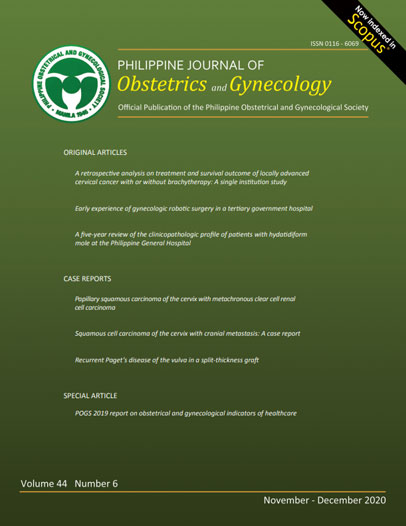Search for articles
Article Detail
A study on the knowledge and management practices of hypertension in pregnancy among midwives in the different public health centers of Cebu City
Maria Carlyn Rodriguez-De Vera, MD and Geraldine Isabella B. Uyheng, MD, FPOGS
Department of Obstetrics and Gynecology, Chong Hua Hospital
General Objective: To assess the knowledge and management practices of midwives in the management of hypertension in pregnancy in accordance to the BEMONC protocol.
Study Design: Descriptive Study
Study Setting: The 69 public health centers of Cebu City
Study population: Public health midwives
Methodology: This is a descriptive study where a survey questionnaire was used and convenience sampling was done. Chi square and Fischer exact tests were employed to compare proportions. Descriptive statistics was used to summarize the data in proportion.
Result: More than 70% of the midwives were knowledgeable regarding expected competencies, where BEmONC-trained midwives were 5-14x more likely to identify appropriate function. However, only a dismal 22-36% will actually administer Magnesium Sulfate, which shows that knowledge is not translated into practice. Also, more than 70% were knowledgeable on the risk factors and danger signs of hypertension. However, only less than 40% knowledge rate was demonstrated in the diagnosis and classification of hypertension in pregnancy. It also showed that midwives agreed to give antihypertensive medications- where Methyldopa was most commonly given. Among those who agreed to give Methyldopa, majority were BEmONC-trained. A number also agreed to give hydralazine and diazepam in the setting of severe preeclampsia and eclampsia, where more non-BemONC midwives agreed. Alarmingly, only less than 50% will refer to a physician in the management of gestational hypertension and mild preeclampsia, and only 50-60% agreed to facilitate hospital transport in the setting of severe preeclampsia and eclampsia.
Conclusion: The BEmONC manual must be updated to keep up with current guidelines and ensure the conversion of knowledge into practice. The BEmONC coverage of training must also be expanded so that all practicing midwives know the protocol. However, the DOH must further strengthen their role in the active surveillance of public health midwives and review the retention of their skills and regular practice of knowledge. Midwives must also be certified proficient, not merely trained. The midwives must also be consulted to explore their problems in the implementation of current guidelines so we can better understand their situation as to why knowledge is not put into practice. By identifying deficiencies, we can improve and address setbacks that have impeded our progress towards achieving the Millennium Development Goal.
Current Issue
Search article

